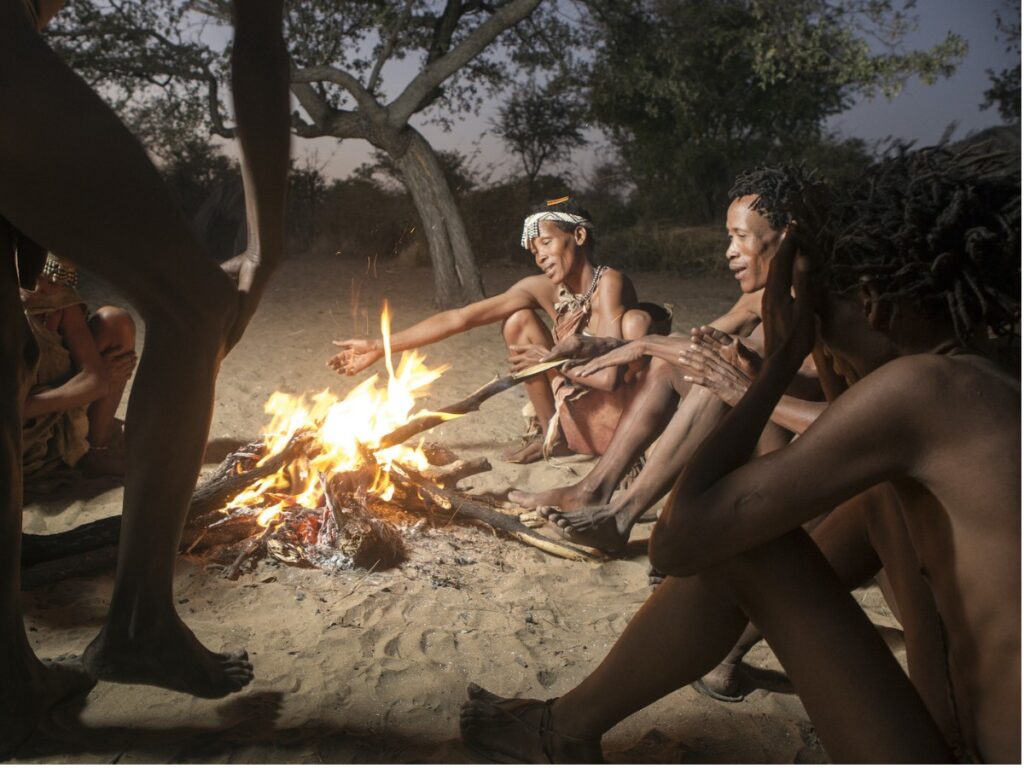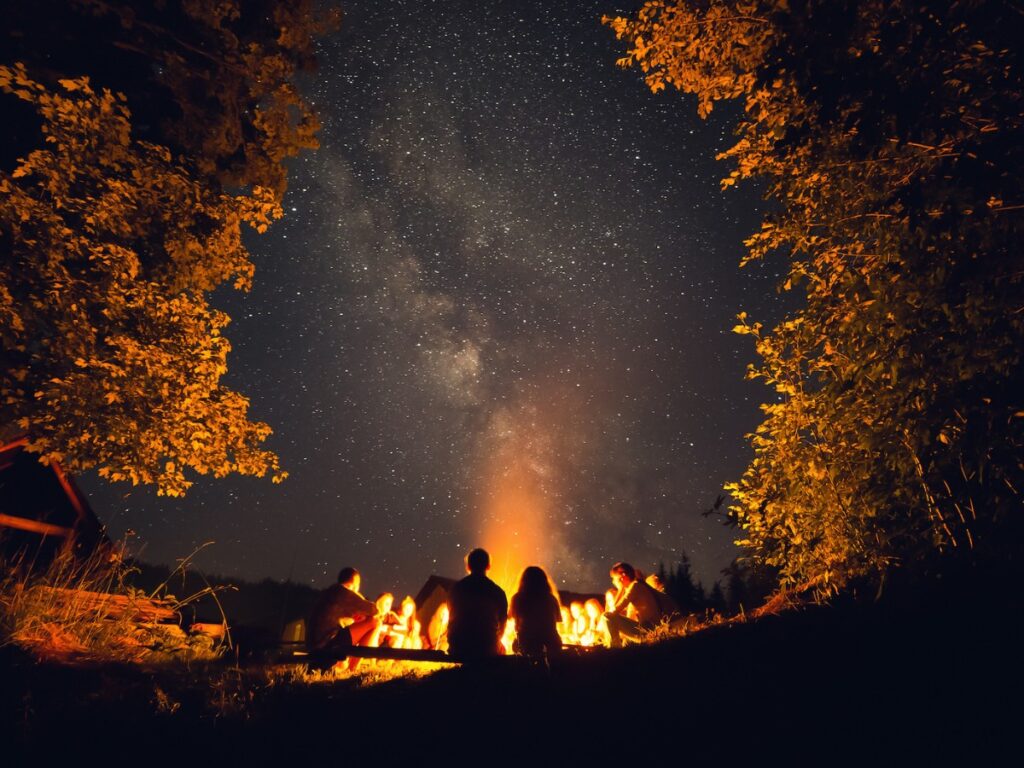
Fire sparked our love of stories, and even helped to forge human culture. In an age of electricity, it’s more important than ever to guard that flame.
We may have come a long way from our hominin ancestors, but in one respect, we haven’t changed very much in millennia. Today, adults typically devote the daylight hours to work and the night-time to tuning out from daily concerns – bonding around shared meals and conversations, and fuelling their imaginations with stories, films and books.
Fire is responsible for that division of time. Around 400,000 years ago, when humans first fully learnt to control fire, it was a breakthrough moment in human evolution. Anthropologists like Richard Wrangham have shown how cooking food allowed our predecessors to draw more energy from what they ate, and so to develop larger brains, transforming their intellectual capacities. (Aptly, Wrangham had his lightbulb moment while sitting in front of his own fireplace.)
Fire also brought a new division of labour, with some groups heading off on hunting trips or in search of wood, while others tended the flame. The need to learn to cooperate meant that humans began to gather together in larger, multi-generational groups. Fire didn’t only protect our forebears from predators and make them more intelligent, it also altered their circadian rhythms, creating an entirely new context for social interactions.
But how exactly did this new firelit space advance human development? It was an area that no one had considered until recently, when anthropologist Polly Wiessner presented the fruits of a groundbreaking research project among the Ju/’hoansi bushmen of Botswana and Namibia.
In her unusually poetic paper for the journal Proceedings of the National Academy of Sciences, Weissner argued that gatherings by the fire may actually have ‘ignited the embers of culture and society’ by helping us to understand and get along with one another, and to develop our communication skills.
Wiessner first visited the Ju/’hoansi in 1974, when they lived as hunter-gatherers (they have since moved to villages and taken up farming). During her stay, she took detailed notes on 174 of their day- and night-time conversations, with a view to contrasting the results. Over the next decades, she returned for several visits to deepen her research, ultimately publishing her findings in 2019.

She found that, whereas 75% of the Ju/’hoansi’s daytime talk was focused on practical work-related issues, complaints and gossip, by night over 80% of exchanges were devoted to singing, dancing, spirituality or enthralling stories that traced ‘the exploits of distant kin, adventures in towns, local politics, truck stories, elephant stories, or experiences in trance.’ She captured that shift in tone in a description of their fireside gatherings today – with much seemingly unchanged from ancient times:
The moon and starlit skies awaken imagination of the supernatural, as well as a sense of vulnerability to malevolent spirits, predators, and antagonists countered by security in numbers. Body language is dimmed by firelight and awareness of self and others is reduced. Facial expressions—flickering with the flames—are either softened, or in the case of fear or anguish, accentuated. Agendas of the day are dropped while small children fall asleep in the laps of kin. Whereas time structures interactions by day because of economic exigencies, by night social interactions structure time and often continue until relationships are right.
These mellower moments in the flickering firelight were vital, Wiessner said, for coming to an understanding of the thoughts of others, and for solidifying social networks. ‘Stories told by firelight put listeners on the same emotional wavelength,’ she wrote, and ‘elicited understanding, trust, and sympathy.’ She also outlined the continuing influence of such practices, as ‘appetites for firelit settings for intimate conversations and for evening stories remain with us today.’

The tradition of gathering around the fire for stories and sharing knowledge hasn’t been extinguished in our modern world: it lives on through picnics, group bonding excursions such as fishing trips and scout expeditions, and ecotourism- or wilderness-oriented holidays. It’s also a staple of life in parts of Africa and the Middle East, where the oral tradition runs strong, and Bedouins regularly congregate around fires after dinner to listen to the appointed storyteller share his tribe’s founding myths.
Stories are essential for explaining not only who we are, but also who we want to be, which is why many businesses seek to harness their transformative powers. Among them, Virgin Group founder Richard Branson has called fireside storytelling a key creative tool for his vision of the company.
‘Telling a story is one of the best ways we have of coming up with new ideas, and also of learning about each other and our world. It’s been happening since humans first inhabited the earth,’ he told Forbes. In 2015, Branson commissioned British Virgin Islands artist Aragorn to build a hand-carved ‘fireball’ that his team gathers round for brainstorming sessions at his residence on Necker Island.
For the rest of us, fireplaces and candles keep the flame burning in our homes. And it’s one that we’re desperate not to put out – hence the wild success of the Danish phenomenon of hygge (cozy social gatherings), with its strategically placed candles and focus on comforting social togetherness. Hygge might have become a marketing cliché, but it’s one that masks a deep-seated human need.
There are still several mysteries about our attraction to fireside stories that Weissner hopes to investigate. After her groundbreaking work with the Ju/’hoan, she has continued her research into what she calls an ‘ethnography of the night’.
One avenue she hopes to investigate is how fire affects humans physiologically – how the red, orange and blue flames of firelight actually impact hormone levels. Another future thread might be the way in which a lack of firelight and storytelling time in our modern culture alters our sense of empathy.
Now that electricity has turned economically unproductive firelit time into potential work time, work and home separations have blurred, and many of us never ‘switch off’. Even if we’re not working overtime, we’re constantly plugged in, sating our desire for stories via smartphones, tablets and laptops, as well as podcasts, with their suggestion of intimacy and a sense of community.
We may have a formidable technological armada that our Homo Sapiens predecessors lacked, but has it outpaced our development? As the eminent naturalist Edward O. Wilson has memorably put it, ‘we have created a Star Wars Civilization, with Stone Age emotions’. But Wilson shies away from doom and gloom, and has spoken of man’s potential to recover a paradise on Earth with an ethic of decency to one another, the application of reason and an acceptance of what we truly are.
A return to the warming, age-old ritual of fireside tales might just hold the answer.


